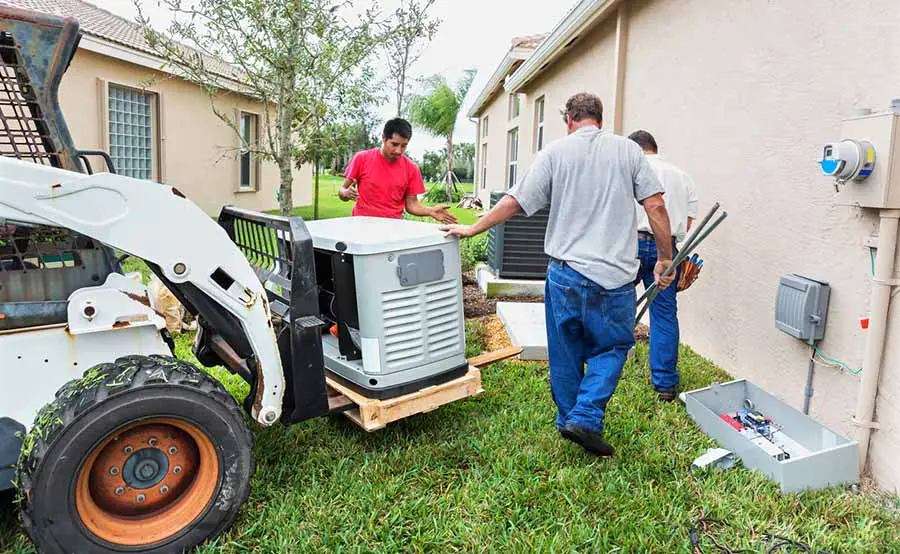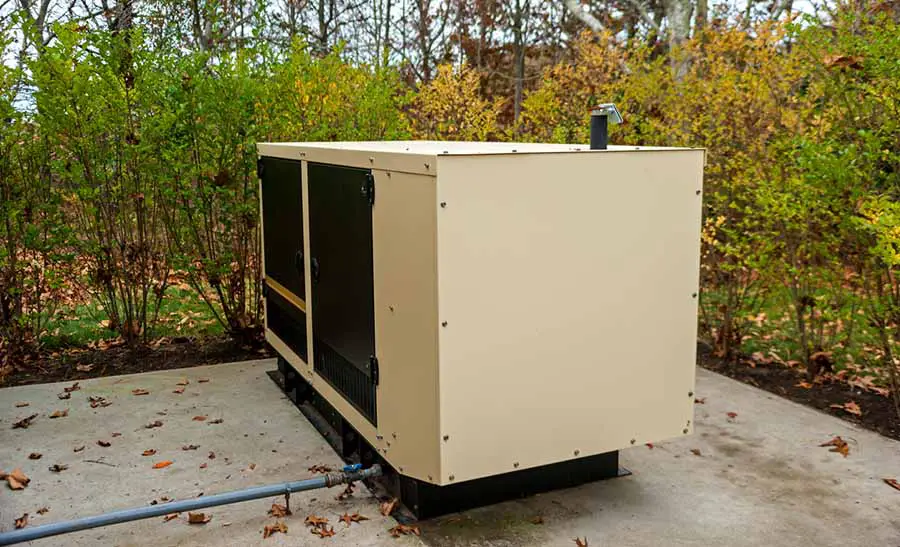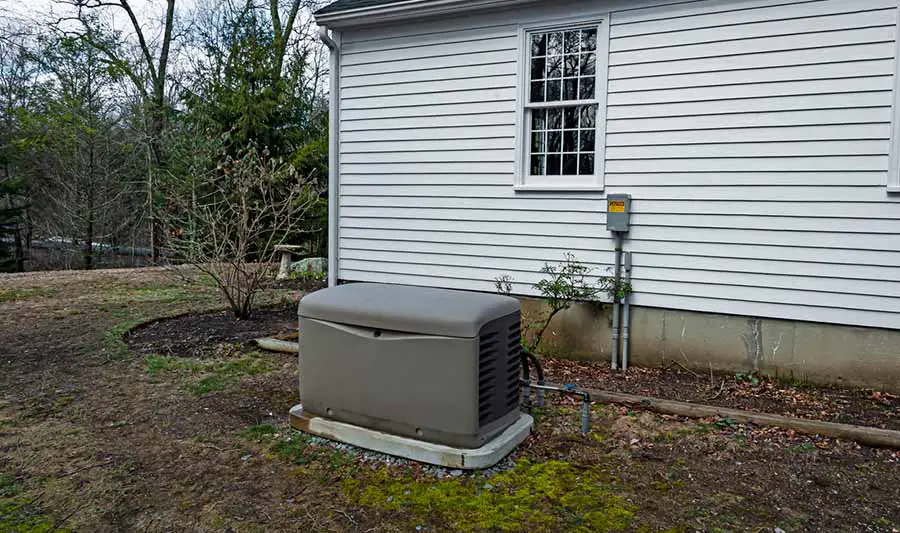
Moving and placing a whole house generator isn’t an easy task. The generators are heavy, with shipping weights of about 600 pounds for 20 KW generators and at least 450 pounds for 10 KW products.
If you decide to lift the whole house generator by yourself, you’ll require lifting equipment and at least one person to help you out with the basics. However, you can also do away with machines and get the assistance of 4-8 physically fit people with good balance and strong backs.
Most of the methods specified by manufacturers on how to move a whole house generator are similar but not the same. Here, we consider some tips on moving your whole house generator successfully.
Moving a Whole House Generator Successfully
Let’s see how you can move your whole house unit with ease.
Warnings When Moving a Generator
- Don’t try to do the job alone. You can ask for help from someone else if you decide to use moving equipment. There is also an option of moving it manually, and you require help from several people.
- Keep an eye on the power lines and never let the lifting equipment get into contact with them.
- Lift the unit using lifting pipes inserted through lifting holes. Never allow the lifting cables to contact your generator roof.
- Avoid lifting your whole house generator by the roof. It’ll damage your generator and void its warranty.
- Most air-cooled whole house generators weigh between 350-600 pounds. The lifting equipment you use should have the capacity to lift your intended weight. If you decide to use manpower, you should have enough people to move the unit.
Moving a Generator Using the Manual Lift Method
If you settle on manual lifting your whole house generator, you need at least four people to do the task. For instance, lifting a 20KW generator with six people means that each person will have to lift and carry about 100 pounds.
The lifting holes at the back and front of your generator accept ⅝-inch or ¾-inch piece pipe. Employ two lengths of 60-inch-long, schedule-40 steel pipes placed through the lifting holes. Ensure you have more people on the heavier side to distribute the generator’s weight evenly.
Everyone involved should lift the generator using the muscles in their legs and not their back. You should bend your knees without bending the back.
Each person involved should grasp the lifting pipe firmly. When every person is ready, you can lift the generator and relocate it to your desired location.
When the generator gets to the destination, ensure you set it the same way you lifted it. Ensure you bend your knees and not the back while setting it down. Withdraw the pipes from the generator after resting them at the intended location.
Lifting a Whole House Generator with Equipment
Apart from lifting the whole house generator manually, you can also do it using lifting equipment. The first step is to insert a 42-inch-long piece of schedule-40 pipe in the lifting holes. Secure your pipes into place using clamps.
Attach chains or lifting cables to the pipes and then to the hoon on your hoist. Employ a spreader bar between the cables or each pair of chains to prevent them from getting into contact with the roof.
You can operate the hoisting equipment while someone helps you to observe the lift. The observer needs to keep a close eye on the power lines and any other obstruction while moving or hoisting the generator. You should never try to lift the generator by yourself.
Move your whole house generator to its final location while exercising caution. Lower the generator and then remove the lifting cables or chains. Finally, remove the pipes.
Where Should You Install a Whole House Generator?

Selecting a location for your whole house generator is a straightforward process, but you must consider some factors. The best location is where the generator can function safely and effectively without endangering the lives of those in the house.
For instance, you should install your generator in a sturdy place that won’t experience flooding. The exhaust gases emitted by a generator also have carbon monoxide.
Here, you need to contact your local building code for necessary permits and requirements. They always have the final say on the plumbing and electrical installations. Experienced plumbers and electricians can work with local building authorities to resolve conflicts between local building codes and installation instructions.
Whole House Generator Placement
You should minimize costs by having your whole house generator closer to an existing electrical service entrance. Electric and gas companies require specific clearances between their equipment and those belonging to other companies or the house owner. It’s the one way the local code authority can assist you to put your generator correctly.
Using a propane whole house generator requires a minimum distance between the generator and the tank’s fill valve. The required distances vary with the locality.
Some guidelines require you to place your whole house generator where prevailing winds blow exhaust away from your house. Place the generator away from the living areas, bedrooms, and where the noise won’t affect your neighbors. The location should be five feet from openings such as soffit vents, doorways, and windows.
Never put your whole house generator in a breezeway, under an overhang, or in recesses blocked by shrubs, trees, or other vegetation. It would also help avoid areas prone to snowdrifts and protect the unit from animals, traffic, people, and pets.
Standard clearance requirements demand 5-feets from a house opening and 3-feets from flammable materials.
House siding materials, manufacturer certifications, and NFPA code govern the distance between the back of the generator and your home. Even though 18-inches is the new standard, your local authorities will have the final say.
Never place a whole house generator in any location that might accumulate exhaust gases either inside the building or under the roof.
Whole House Generator Pads
After identifying the perfect location for your generator, you need to have it approved by the local authority and get a building permit. There is no worse feeling than buying materials and installing them only to have an inspector fail the installation because you didn’t get a permit or failed to meet local codes.
A passed inspection and permit guarantee that the insurance company will honor its policy if there is damage or fire.
You might come across some local codes that require you to install a concrete pad for the generator to sit on. Others allow it to sit directly on pea gravel or a bed of gravel. However, most manufacturers will supply the generator in an enclosure with a suitable base for the generator.
A bed developed from compacted sand and pea gravel at the top makes the best pad. Remove the dirt and sod to create a rectangular-shaped hole that is 6-inches deep. Incorporate a 3-inch layer of damp sand and then compact it.
You can create a 2×4 frame from pressure-treated lumber or cedar to help enclose the gravel and keep it out of the grass and on your pad. Level your frame using a spirit level, fill it using pea gravel, and set your whole house generator on it.
However, whole house generators come with a composite pad sitting on the soil with no prepared gravel bed.
Even if the local codes require a concrete pad, it’ll be best to develop a base of compacted sand and then set a frame over it. Level your frame and fit it using concrete. You can then place your generator in position once the concrete hardens and cures.
Considerations When Installing a Whole House Generator
Ice storms, tornadoes, hurricanes, electrical storms, and flooding can cause damage to the electrical grid and plunge your house into total darkness for days. There is, therefore, the need to install a whole house generator as a backup for electricity.
A whole house generator will offer enough power to power some of the critical components in your home. If you have purchased a new generator or want to install an old one after moving it from a different place, there are considerations before installing it.
1. Generator Capacity
At the top of your considerations should be your generator capacity. The more components and devices you would like to power, the more expensive and bigger the whole house generator you’ll need.
For instance, you should install a 20kW rated whole-house generator to power your entire house successfully. You should carry out enough research to determine the size of the generator that is perfect for your needs. There is also an option of asking a contractor who specializes in installing whole house generators to help you out.
2. Selecting The Right Fuel
The generator won’t be of any use if it doesn’t have any fuel. There are at least four major fuel sources for a whole house generator, including natural gas, LP gas, diesel, and gasoline. Gasoline isn’t a good option for whole-house units since it’s highly volatile, making it difficult to store.
Diesel
Diesel is among the common sources of fuel for whole house generators. The fuel is less volatile and stable than gasoline. It also has a higher energy content. However, you’ll have to include an external tank to hold diesel for your whole house generator.
Propane (LP Gas)
Propane gas is easy to store and safe to use. Storage tanks range from 100-1000 gallons. Even though it doesn’t contain a high energy content like diesel, it’s the perfect fuel for a whole house generator.
Natural Gas
Natural gas is reputable for burning cleanly. Natural gas offers the best fuel option for a whole house generator.
3. DIY Option
You can save a lot of money by moving and installing the generator yourself. Even if you don’t have the required skills yet, you can always read the steps from youtube. However, ensure you consider all the factors for installing a whole-house unit.
- Electrical connections: Whole house generators employ an automatic transfer switch for selecting an outage and starting the generator.
- Plumbing connections: If you’re using propane or natural gas, you might have to connect a propane tank or gas line to the generator. Ensure that you have the right valves.
- HOA restrictions/building permits: Depending on your locality, you might be forced to have a moving or installation permit for your whole house generator. You also need to consider the restrictions put in place by a homeowner’s association.
- Site selection: The generator comes with the manufacturer’s guidelines on how close it’s supposed to be to your home. Follow the guidelines keenly.
What Is the Lifespan of a Whole House Generator?

Like other engines, the lifespan of your whole house generator depends on several factors. In most cases, the lifespan of these generators ranges between 20-40 years. The actual period is determined by how many running hours you use it, how often you exercise it, and how well you maintain it.
We know that proper upkeep and maintenance will extend the lifespan of a whole house generator. There are a few approaches that can extend the lifespan of your unit.
First, allow the whole house generator to exercise regularly without a load. Most brands design their generators to turn on automatically to exercise several times per week. It helps to prevent moisture buildup and wet stacking.
Secondly, you need to perform routine maintenance every time. Here, you need to check the oil lines, test and clean the battery, and change the oil in the engine. The generator will run effectively and for longer periods if you do this.
You can finally enroll in a scheduled maintenance program to ensure your generator’s longevity. Here, you’ll get proven tips on how you can make your unit better.
Does a Whole House Generator Increase Home Value?
Improving your home by adding a whole house generator can increase the value of your home. A whole-home generator falls under the home investment category.
Below are ways through which a whole home generator improves the value of your home:
1. Resale Value
Not all generators are designed and created equal. However, a professionally designed and installed generator can provide up to 150% return on investment. Even though markets might vary at times, incorporating a whole house generator can increase the resale value of your home by 3-5%.
2. Home Insurance
Apart from the value of your home increasing, having a whole house generator can also reduce your home’s insurance rates.
3. Replacement and Repair Costs
Most of the time, power outages are unavoidable. At least 80% of the power loss results from inclement weather. When power is lost, you might experience unexpected costs such as:
Plumbing Complications
For instance, a business or home that relies on electricity for plumbing purposes might experience sewage flooding or limited use of hygienic functions. With flooding, you’ll experience molds.
Damage to Equipment
Commercial buildings service or operate equipment that depends on a continuous source of power. Any prolonged or sudden loss of power translates into costly damage to equipment.
4. Temporary Housing Costs
When you don’t have power in the house, you might seek a temporary housing option. It might involve spending a night or two in a hotel. The costs of housing might skyrocket at a fast rate. Having a whole house generator will save you the hassle of spending the night at a hotel and incurring additional expenses.
5. Protection Against Income Loss
At the moment, the majority of the people are working from home, leveraging commercial buildings, or running home-based businesses to provide for their families. There is overdependence on reliable power to keep getting the job done. The ability to provide services/products to your customer or access work protects your family’s bottom line.
6. Peace of Mind
The ultimate value added to a whole house generator is immeasurable. Peace of mind, convenience, safety, and comfort in knowing that your business or home will keep operating in case of an emergency is priceless.
Conclusion
Moving a generator is a very straightforward process if you understand the steps. You can either decide to do it by yourself or use lifting equipment. When you decide to do away with lifting equipment, ensure you seek the assistance of 4-8 physically fit people having good balance and strong backs.
As we have seen, having a whole house generator in your home increases the value of your home. However, you need regular maintenance to improve the lifespan of your generator.
Before you install a whole house generator, ensure that you follow the considerations we have recommended above. We hope you move your generator successfully.

